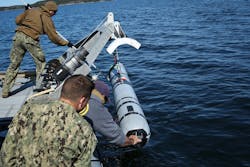Navy researchers tap Draper Lab for enabling technologies in machine autonomy for unmanned undersea warfare
ARLINGTON, Va. – U.S. Navy unmanned underwater vehicle (UUV) experts needed enabling technologies for specialized machine autonomy in future undersea vessels. They found their solution from the Charles Stark Draper Laboratory in Cambridge, Mass.
Officials of the Office of Naval Research in Arlington, Va., announced a $23.7 million five-year contract to Draper earlier this month for the Full Spectrum Undersea Warfare Innovative Naval Prototype Unmanned Underwater Vehicle Autonomy and Simulation Development and Support effort.
Draper experts will develop specialized autonomy using a model-based systems engineering approach for artificial intelligence (AI) and machine autonomy in UUVs for tasks such as automated target detection and recognition, autonomous behaviors, signal processors, advanced machine learning techniques, and multi-vehicle collaborative autonomy.
This unmanned undersea vehicles project is part of the Long Range Broad Agency Announcement (BAA) for Navy and Marine Corps Science and Technology. Draper will do the work in Cambridge, Mass., and should be finished by January 2029.
For more information contact Draper Laboratory online at www.draper.com, or the Office of Naval Research at www.nre.navy.mil.
